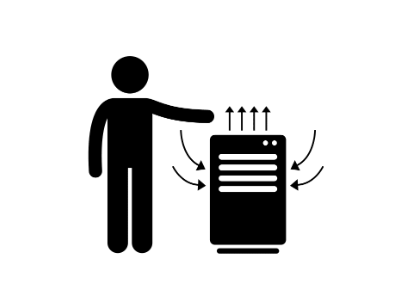
IDAQ Testing
Why Indoor Air Quality (IDAQ) is important to the school environment:
Numerous aspects create an atmosphere conducive to the children’s well-being and safety at school. The maintenance of a high level of indoor air quality is one of those things that is incredibly vital yet is frequently neglected.
The poor air quality inside schools can directly impact students' academic performance and create a harmful environment for the children who attend those schools.Indoor air pollution has been regularly placed among the top five environmental threats to public health, according to studies that have been carried out as part of several surveys.
This is because most individuals spend about ninety percent of their time indoors. Students, in particular, spend most of their time on the weekdays inside a classroom setting.
A healthy learning environment for kids and a teaching setting for faculty members require adequate ventilation and air quality within the building. You can get indoor air quality (IDAQ) management services from Mechanical Testing Inc, and those are mentioned as follows:
- The preservation of a temperature and relative humidity within acceptable limits.
- The regulation of pollution in the air.
- The introduction and distribution of sufficient fresh air from the outdoors.
Since "bad air quality" is frequently attributed to indoor temperature and humidity complaints, it's impossible to ignore this critical factor. In addition, various environmental conditions influence the concentrations of pollutants within a building.
It's important to consider that a school's windows, doors, and ventilation systems let in fresh air from outside. As a result, the interior pollution levels and the outdoor air quality on school grounds are influenced by traffic and grounds maintenance operations.
Several aspects of inadequate Indoor Air Quality (IDAQ):
There are both short-term and long-term effects to mismanaging indoor air quality. It can have a variety of negative consequences, including:
- Allergy symptoms
- Eye inflammation
- Coughing
- Highly unusual circumstancescan lead to potentially fatal illnesses, such as legionnaire's disease or carbon monoxide overdose.
- Pain and headaches
- Respiratory diseases such as asthma might be exacerbated.
Inadequate management of the interior air quality in your school can have consequences on your school’s activities, in addition to the physiological impacts that poor air quality causes. It is possible for there to be an increase in the possibility of school closings due to illness outbreaks, which in turn generates negative publicity.
There is also the possibility that the attendance and performance of students and teachers will reduce. Additionally, the school's physical equipment may degrade faster because it is not working as efficiently. If you simply maintain HVAC equipment annually, through checkups, filter replacements and air flow readings you can extend the life of your equipment and save money long term.
What Are the Best Ways to Control Indoor Air Quality?
Investing in a device that monitors the air quality within a building may ensure that the air inside the building is safe to breathe while also ensuring that any ICB-certified equipment is operating as effectively as possible.
Because children's bodies are still developing, they may be more vulnerable to the effects of poor air quality than the bodies of grown-ups. This is one of the reasons why the air quality in schools is essential and why steps need to be taken to ensure that the indoor air quality in schools is at its ideal level.
Keeping an Eye on the Indoor Air Quality (IDAQ):
IDAQ, like other environmental health concerns, may be effectively monitored to assess the current risk and improve the air quality. Volatile organic compounds (VOCs), which are not visible to the naked eye, can be detected with control and monitoring capabilities to pick up on their signals.
The presence of musty odors, odor condensation, or even condensation on the ceiling can indicate poor indoor air quality in a specific region. Still, they cannot reveal the source of the problem. For the safety of the building's residents, a linked monitor ensures that the air quality is maintained.
Typical Pollutants in the Atmosphere:
A wide range of common pollutants can be found in public places such as workplaces, households, schools, and hospitals. These pollutants include VOCs, secondhand smoking, radon, nitrogen dioxide, lead particles, asbestos or other construction materials, mold, or mildew. Human-created and natural contaminants exist.
Mold and mildew can be found in household furniture, while non-energy efficient appliances can create smoke and chemical pollutants. It's typical for mold and mildew to grow in the attic or basement of a home located in a humid environment because of the moldy smell and other telltale
Vehicles and public transportation systems that are more efficient in energy use also lower the smoke and emissions people breathe in. The air quality is determined by several elements, just one of which is public environmental issues.
Indoor environments of any kind, including homes, places of business, educational institutions, buildings, schools, and hospitals, are susceptible to the damaging impacts that may be caused by commonplace items, construction materials, and natural contaminants. In confined environments, volatile organic compounds (VOCs), carbon compounds, and other environmental pollutants are usual.
Wrapping It Up:
Keep an eye on your indoor air quality (IDAQ) and educate yourself on how to enhance the fresh air quality in your schools and offices to prevent potential health issues, annoyances, or even more significant concerns in the future. You need to know entirely about indoor air quality (IDAQ). Because your health is in your own hands.
For the benefit of your health and the health of people who live in or visit the area you oversee, it is necessary to learn how to monitor air quality and keep track of this information. The short-term and long-term effects on your health can be affected by using a carbon monoxide and radon sensor integrated into your smartphone or having an air quality monitor.
An individual's health and well-being are intimately linked to the quality of the fresh air they breathe. In general, people prefer to spend most of their time inside. An atmosphere free of harmful contaminants can improve quality of life, minimize respiratory infections, and lessen the risk of many chronic problems.




